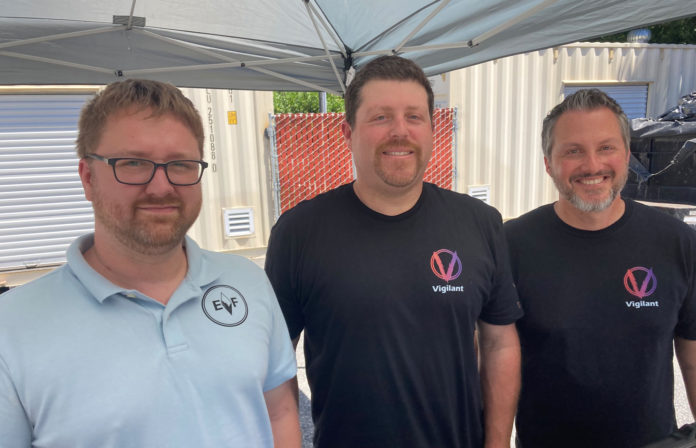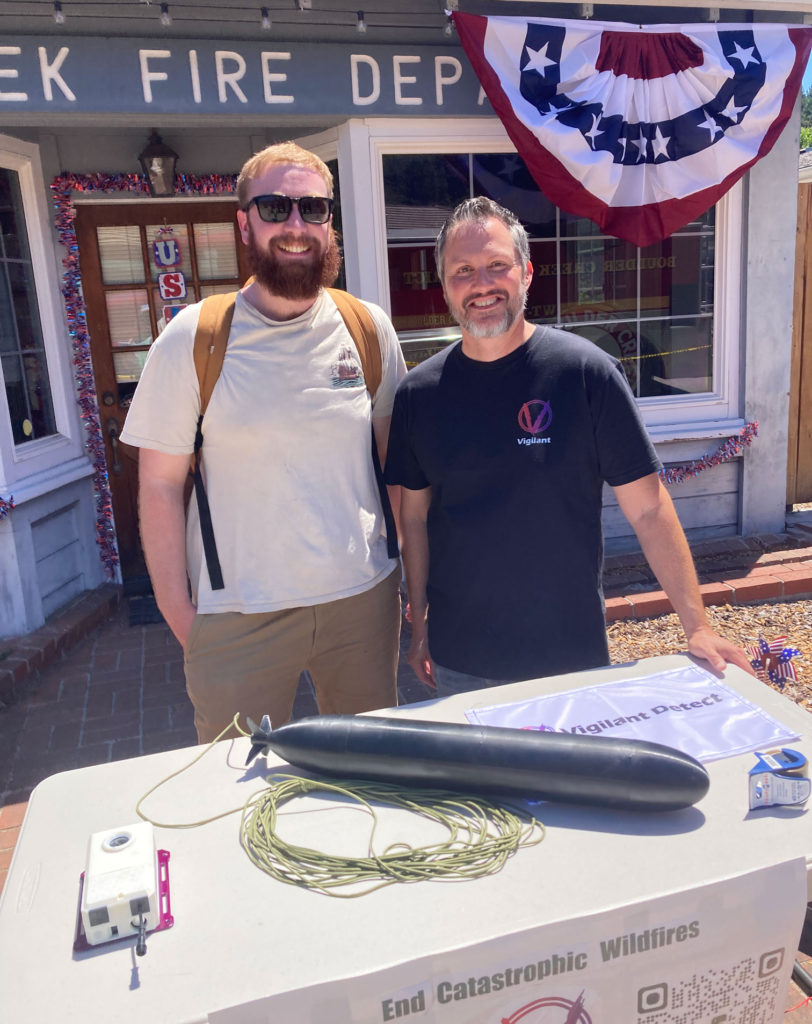
Ember Flash Aerospace, a Santa Cruz County company with deep ties in the San Lorenzo Valley, has been named a semifinalist in the XPRIZE Wildfire competition, a years-long challenge meant to inspire solutions that will stamp-out the possibility of extreme forest fires.
Zach Ackemann, who works in business operations for the company, lives in Felton and served with the Felton Fire Department from 2016-21.
“I was their training coordinator,” said Ackemann, adding he deployed during the 2020 CZU Lightning Complex Fire. “Resources were very limited during that—across the whole state.”
That led him to want to be part of something that could help solve that issue.
“We all had families, we all had friends, who had their houses burn,” he said. “So, in the years following that, a group of us throughout the (San Lorenzo) Valley came together.”
He’s referring to a unique piece of technology in front of him.
“We call this Vigilant Detect,” he said. “These will detect smoke and triangulate the location of that (fire).”
But they’re trying to build-out a model where they don’t just identify the problem, they also put it out. And for that, they’ve developed what looks like a torpedo.
Right now they’re building a fixed-wing drone to be able to deliver payloads that can stop the spread of a wildfire that’s in its early stages. It would be like a fire extinguisher in the sky.
Boulder Creek resident Brian Barbe, the company’s chief technical officer, said Paul Faraone, the owner of River Dogs hotdog shop, even played a key role in connecting local talent together.
“It really did come out of a community effort to address this problem,” Ackemann said.
The XPRIZE Wildfire is an $11 million challenge sponsored by PG&E and the Gordon and Betty Moore Foundation.
There are two different “tracks” of the competition happening simultaneously.
On July 14, organizers announced 11 teams from five countries advancing to the next phase of the “space-based wildfire detection & Intelligence track.”
This includes Ember Guard, from Palo Alto, which is led by a high school student and features materials scientists, entrepreneurs, wildfire-focused atmospheric modeling experts, mathematicians and senior research scientists; and Orbital Sidekick, from San Francisco, made up of hyperspectral imaging and data scientists, payload engineers, technical leaders, product managers and user interface/user experience designers.
And in the “autonomous wildfire response track” there are currently 15 teams from seven countries advancing to the next round.
Among the semifinalists is Wildfire Quest, from San Jose, a group of students from Valley Christian High School; and Ember Flash Aerospace, with their advanced unmanned air systems that integrate data analytics and decision-making tools to maximize situational awareness to respond to natural disasters.

XPRIZE Wildfire Program Director Andrea Santy said wildfires have been growing more frequent and severe year after year.
“We launched XPRIZE Wildfire because the world can no longer afford to treat destructive wildfires as inevitable, and we know that breakthrough technologies can fundamentally transform how we detect, manage and fight wildfires,” Santy said. “The teams advancing in the competition are bringing that vision to life, and over the next year, they’ll face rigorous real-world testing to prove their technologies can perform when it matters most.”
Andy Abranches, PG&E vice president of wildfire mitigation, said their company has been focused on developing a layered system to mitigate wildfires.
“We work closely with innovators to adapt—and adopt—tools and technologies giving us new data, insights, visibility and capabilities to prevent fires and when necessary, limit their spread and size,” he said. “We recognize the need to develop the technology of tomorrow and are excited about the new possibilities being unlocked by the XPRIZE Wildfire innovators who share our commitment to preventing catastrophic fires.”
Ember Flash co-founder Steve Lindsey, 42, is also a Boulder Creek resident.
“We have multiple ways that we can look for indicators of fire,” he said.
Of course, they can spot warning signs visually via their cameras. But they also have particulate sensors.
“It can pick up gas leaks,” he said.
And they work with partners to leverage things like satellite data and weather balloon readings, Lindsey explained.
“We’re not holding anything back to find indicators of fire,” he said.
They’re currently working to get their drone licensed to fly and begin responding to wildfires.
“It flies at about 100 miles per hour,” Lindsey said. “It flies up to five miles or so.”
When asked about the XPRIZE, he’s careful not to get his hopes up too much.
“We’ll see if we continue in it,” he said.
That’s not to say they don’t have high hopes.
Ember Flash is already beginning to work with international partners.
“We’re partnering early with a lot of companies,” Lindsey said. “We’re going to be global.”
Their sensors are already strapped to the mast above the Boulder Creek Fire Protection District headquarters, as Ember Flash works to test their equipment and data analysis capabilities.
Lee Kohlman, 40, used to live in Boulder Creek, but relocated a couple years ago to Ohio.
That means that this Ember Flash team member was also caught up in the CZU Lightning Complex Fire madness.
“My wife and I were out here,” said Kohlman, recalling the evacuation. “We were some of the first out.”
He’s hoping his 14 years of working for NASA will help them clinch the XPRIZE.
“We want to make sure our technology’s scalable, deployable and affordable,” he said. “Some of the communities that are most at risk are also the most economically disadvantaged.”
They are also trying to build privacy into their systems. For example, in their public demonstrations, they show video footage where humans are automatically blocked out with a black rectangle.
Catherine Ball, an XPRIZE Wildfire advisory board member, said technology can be a “force multiplier” in the battle against dangerous wildfires.
“The teams advancing in XPRIZE Wildfire are proving that we don’t have to accept destruction as inevitable,” Ball said, via email. “This is what 21st-century climate resilience looks like: bold ideas, tested rigorously, and deployed at a planetary scale.”
For more information on Ember Flash, visit emberflash.com.












